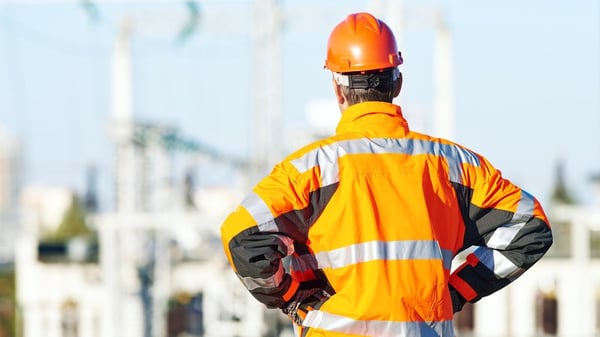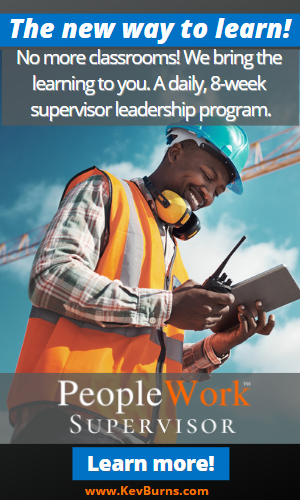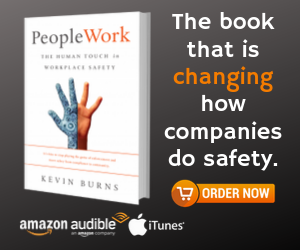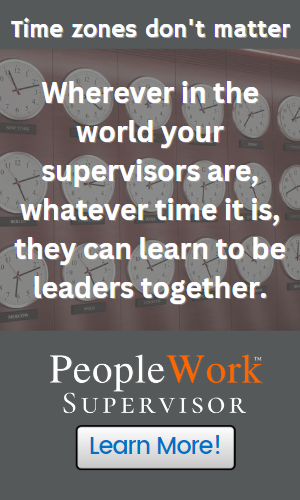Are supervisors the key to future safety performance?
Supervisors armed with leadership skills and team-building tools create a greater sense of purpose on the front-line.
Once upon a time, supervisors were chosen by either being the most senior person on a worksite or by being the best out of all members of the crew. Then, that person would take over as crew chief and lead their teams through the production and deadlines. But it was usually done without any training or much support from higher-ups.

It was especially troubling if that new supervisor didn’t hold much faith in safety or if they gave minimum effort to adhering to safety protocols. Production, in their minds, was most important. Safety just slowed them down, so they thought.
Whatever mindset the supervisor holds about safety, their team will adopt that same mindset in short order. Then, instead of a single person you have to correct, you will be working with a whole team whose behaviors need to change.
A Shift in Mindset
Over these past few years, there has been a concerted effort by smart, caring companies to recognize the role that supervisors can play in improving safety performance, teamwork, and employee engagement. Supervisors are being armed with leadership skills and team-building tools in order to to create a greater sense of purpose on the front-line.
Any employee who arrives at work with a greater sense of purpose, a willingness to look out for their fellow employees, and an elite-level team mindset is an engaged employee. Engaged employees pay attention to their work and that especially includes safety.
So, it seems the key to high levels of safety engagement start with high levels of job engagement. That engagement is lead by the level of engagement of the employee’s direct supervisor.
The Influence of Supervisors
Employees do what their immediate supervisors do. A supervisor who gives minimum attention to safety demonstrates to their team how he/she expects safety to be handled. A supervisor who views safety as important soon has their team of employees following their lead.
It only takes a few conversations with one’s boss before the employee soon figures out what is important to the boss and where they are being scored. Employees do what their bosses do.
In hundreds of conversations with front-line safety personnel, I have listened to too many stories of how safety personnel felt undermined by front-line supervisors. That once the safety person turned their back, supervisors would encourage their teams to going back to the way they had been doing things previously.
There is no question that the greatest source of influence is that of the front-line supervisor. So, if you want your safety program to improve quickly, the supervisor needs to become part of the solution.
But that supervisor needs skills and tools to be able to play an important role in securing the safety of employees.
The Long Way is The Best Way
On old saying comes to mind: “people don’t just change their minds, they make new decisions based on new information.”
Supervisors aren’t going to suddenly change overnight or after completing 8-hours of classroom instruction. You must be in it for the long haul.
Supervisors need to be treated as safety's valuable assets and have their skills, tools, and training reinforced constantly. No one carries more influence with a crew of employees than the person who interacts with them daily. That includes middle or senior managers.
You cannot think about promoting an employee to supervisor and then not supporting that supervisor with skills development and leadership training. Skills development needs to support the idea of continuous improvement.
Past Experience Stops Being Most Important
You wouldn’t let a new employee operate a piece of heavy machinery without proper training? So how can you let a new supervisor operate a team without proper training?
Once an employee becomes a supervisor, their 20-year trades ticket is no longer the most important tool. That's because they stop doing their trades work and 80% of their new job is in coaching, communicating, motivating, and team building.
Their employees don't succeed based on how good their supervisor used to be at the job. Employees are more concerned with how good they are about to become under their new coach and mentor.
A key aspect of successful supervisory is when the supervisor wants their employees to be able to surpass their own skills level. Nothing should make a coach prouder than to see individual members of their team excel at their work.
When employees succeed, it gives meaning to the supervisor’s work. Employees who celebrate successes often, tend to remain loyal to their employers. And the longer a team works together, the better they become at safety performance.
Focus on These 3 Areas Immediately
Supervisors are key to future safety performance. Here are three areas that you must engage immediately.
- Identify the key character traits and skills that you want all supervisors to possess. Write out the list, discuss it, add to it, and then before anyone else gets promoted to supervisor, ensure that the person you pick is the right supervisor – not the most senior.
- Look at the turnover rates under each existing supervisor. The supervisor who turns over the most employees will likely also have a greater number of safety incidents. Identify your “must address” supervisors and prepare to help them with skills development.
- Embark on a skills development program. Skills are not acquired in a day. Skills are acquired using a combination of instruction, mentoring, time, and repetition. The Safety Communication & Coaching for Supervisors Program does exactly that over 12 weeks. Think long-term, ongoing skills development for your supervisors.
--
Kevin Burns is the President/CEO of KevBurns Learning. Kevin works with smart, caring companies to energize safety culture, build teamwork, and improve employee participation in safety.
In 2020, BookAuthority.org named PeopleWork #7 of The Top 44 Workplace Safety Books of All Time. Buy yourself a copy of PeopleWork: The Human Touch in Workplace Safety and give another as a gift to a colleague.
Subscribe to Kevin’s Blog.





